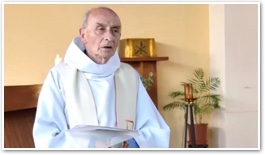The martyred priests
- FATHER RAYMOND J. DE SOUZA
There are others. Many others. We mourn them. We allow ourselves a righteous anger. We admire them. We honour them.
 The news of the beheading of Father Jacques Hamel in Normandy arrived here just as World Youth Day, the massive weeklong Catholic festival — held in Toronto in 2002 — was beginning. The killing of an octogenarian man was inhuman, the killing of priest a grave sacrilege, and that it was done in a church, at the altar while Father Hamel was celebrating the Eucharist, makes it a blasphemy that cries out to heaven.
The news of the beheading of Father Jacques Hamel in Normandy arrived here just as World Youth Day, the massive weeklong Catholic festival — held in Toronto in 2002 — was beginning. The killing of an octogenarian man was inhuman, the killing of priest a grave sacrilege, and that it was done in a church, at the altar while Father Hamel was celebrating the Eucharist, makes it a blasphemy that cries out to heaven.
To say that he was killed while about his sacred work is correct but not complete. His sacred work includes being killed.
In the Catholic way of understanding the priesthood, the priest is not primarily a pastor, a teacher or administrator, though he does all those things. He is primarily, by virtue of his ordination, to act in the person of Christ, to do what Christ alone can do. That's why, when Father Hamel offered the Holy Mass he said "this is my body" and "this is my blood." He speaks as if Christ himself is speaking which, sacramentally, is exactly what is going on. If the priest is to be another Christ, to do what Christ does, then martyrdom is part of his sacred mission, for Christ died for us.
When Pope Francis arrived here Wednesday he went straight to Krakow's cathedral to venerate the relics of St. Stanislaw, the Cracovian bishop killed in 1079 at the altar while he was offering the Holy Mass. In the cathedral of Vilnius a painting of the martyrdom of St. Stanislaw hangs over the main altar. I had occasion to pray before it just a few days before coming to Kraków, a few days before Father Hamel was also murdered at the altar, 937 years after Stanislaw.
English-speakers are more familiar with the martyrdom of St. Thomas Becket, the archbishop of Canterbury who was killed at the altar in 1170 for opposing the king's usurpation of the freedom of the church. T. S. Eliot kept that memory alive in his play Murder in the Cathedral.
It is the mission of the priest to be present and accounted for whenever the suffering of mankind is most intense. When Pope Francis visited Auschwitz, he visited the starvation bunker where St. Maximilian Kolbe, a Franciscan friar, was imprisoned to die — 75 years to the day after Kolbe offered himself in place of another prisoner. The camp guard sneered at Kolbe's astonishing offer and asked, "Who is this Polish swine?" Kolbe replied simply, "I am a Catholic priest."
During the Second World War, the prison camp at Dachau was the largest monastery, so to speak, in the history of the world, where the Nazis interned 2,500 Catholic priests.
In 1980, archbishop Oscar Romero of San Salvador, a true father to the poor, denounced the government's death squads and pleaded with them to ignore orders to kill civilians. They shot him to death while celebrating Mass in a hospital chapel. In 1984, the Polish secret police was exasperated at the monthly "Masses for the fatherland" that Father Jerzy Popiełuszko would offer in Warsaw, at which he would preach to thousands upon thousands, urging them "to overcome evil with good." The evildoers overcame Father Jerzy, beating him to death and dumping his body in a reservoir. I keep a small photo of Father Jerzy in my kitchen.
Even absent martyrdom, the priest is summoned to the laying down of his life. We think of St. Damian, the Belgian missionary priest who chose to live in the leper colony in Molokai, caring for the lepers until he himself contracted the disease and died there. We think of Father Mychal Judge, the chaplain of the New York fire department, who rushed into the World Trade Center. He was not the first to die on 9/ 11, but his death was the first to be recorded there. The Catholic notes that and thinks, yes, Jesus in his priest was present and accounted for among those killed.
We should expect then that the lethal scourge of jihadist violence will include my brother priests.
We think of Father Andrea Santoro, killed in his church in Trabzon, Turkey, in 2006.
We think of Father Ragheed Ghanni, a student in Rome at the same time I was. In 2007, after emerging from celebrating Mass at Holy Spirit Chaldean Church in Mosul, Iraq, he was murdered along with three subdeacons, killed in his car by a hail of gunfire, the bodies left in the courtyard as warning to others.
We think of Father Saad Abdal Tha'ir and Father Waseem Tabeeh, killed during the massacre at the Syriac Catholic Cathedral in Baghdad in 2010. They tried to persuade the terrorists to let the people go, offering their lives in exchange. The killers rejected their offer, and both priests were soon martyred, among the 58 killed during Sunday Mass. The last words of Father Tha'ir, who died before his own mother's eyes, were, "Jesus, into thy hands I commend my spirit," echoing the words of the Church's first martyr, St. Stephen, as recorded in the Acts of the Apostles.
There are others. Many others. We mourn them. We allow ourselves a righteous anger. We admire them. We honour them. And we pray that if the day should come, we, their brother priests, will imitate them, and die like them.
 This is Meaghen Gonzalez, Editor of CERC. I hope you appreciated this piece. We curate these articles especially for believers like you.
This is Meaghen Gonzalez, Editor of CERC. I hope you appreciated this piece. We curate these articles especially for believers like you.
Please show your appreciation by making a $3 donation. CERC is entirely reader supported.

Acknowledgement
 Father Raymond J. de Souza, "The martyred priests." National Post, (Canada) August 2, 2016.
Father Raymond J. de Souza, "The martyred priests." National Post, (Canada) August 2, 2016.
Reprinted with permission of the National Post and Fr. de Souza.
The Author
Father Raymond J. de Souza is the founding editor of Convivium magazine.
Copyright © 2016 National Post



